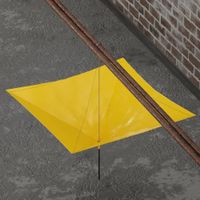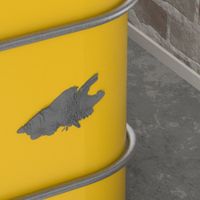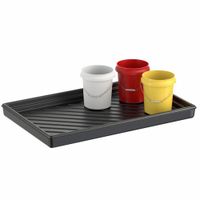Call +(254) 703 030 000 / 751 483 999 / 721 704 777
- Home
- Safety
- Sorbents Spill Control Spill Containment
- Spill Trays Drip Pillows Leak Protection
.....Read More
Frequently Asked Questions
What are spill trays used for?
Spill trays are containment solutions designed to manage and control the accidental release of liquids, particularly hazardous substances, in various settings. They are commonly used in industrial, laboratory, and commercial environments to prevent spills from spreading, thereby minimizing the risk of accidents, contamination, and environmental damage.
Primarily, spill trays serve as a safety measure to catch drips, leaks, and spills from containers, machinery, or equipment. They are strategically placed under potential leak sources, such as chemical drums, oil containers, or laboratory apparatus, to capture any escaping liquid. This containment helps in maintaining a clean and safe workspace, reducing slip hazards and preventing the spread of potentially harmful substances.
Spill trays are made from materials resistant to the chemicals they are intended to contain, such as polyethylene, stainless steel, or other durable plastics. Their design often includes raised edges or lips to ensure that liquids are effectively contained within the tray. Some spill trays also feature grating or platforms to elevate containers, allowing any leaked liquid to drain away from the base of the container, further preventing corrosion or damage.
In addition to safety, spill trays facilitate compliance with environmental regulations and industry standards that mandate proper spill management and containment. By using spill trays, organizations can avoid costly fines and legal liabilities associated with improper handling of hazardous materials.
Moreover, spill trays contribute to sustainability efforts by enabling the recovery and reuse of spilled materials, reducing waste and resource consumption. They are an essential component of spill response plans, providing a first line of defense in spill containment and cleanup operations. Overall, spill trays are a practical, cost-effective solution for managing liquid spills and ensuring a safer, more compliant working environment.
How do drip pillows work?
Drip pillows, also known as irrigation pillows or tree watering bags, are designed to provide a slow, consistent release of water to plants, particularly trees and shrubs. They are typically made from durable, weather-resistant materials and are placed around the base of a plant. The pillow is filled with water, which then seeps out gradually through small holes or a permeable fabric, ensuring that the water is delivered directly to the root zone over an extended period.
The slow release of water helps to prevent runoff and evaporation, making it an efficient method of irrigation, especially in areas with water restrictions or during drought conditions. This method ensures that the plant receives a deep watering, encouraging deep root growth and improving the plant's overall health and drought resistance.
Drip pillows are easy to use: they are filled with a hose and can hold several gallons of water, depending on the size. Once filled, they can provide water for several hours to a few days, depending on the design and environmental conditions. This reduces the frequency of watering and the labor involved, making them a convenient option for gardeners and landscapers.
Additionally, drip pillows can help prevent overwatering, as they deliver a controlled amount of water. This is particularly beneficial for young trees and newly planted shrubs, which require consistent moisture to establish their root systems. By providing a steady supply of water, drip pillows can enhance plant growth, reduce transplant shock, and improve survival rates.
What is the difference between a spill tray and a collapsible spill tray?
A spill tray and a collapsible spill tray are both used for containing and managing spills, particularly of hazardous materials, but they differ in design and functionality.
A spill tray is a rigid, non-collapsible container typically made from durable materials like plastic, metal, or fiberglass. It is designed to catch and contain spills, drips, or leaks from containers or machinery. Spill trays are often used in industrial settings, laboratories, or any environment where hazardous liquids are handled. They provide a stable and reliable solution for spill containment but require dedicated storage space due to their fixed shape and size.
A collapsible spill tray, on the other hand, is designed for portability and space efficiency. Made from flexible materials such as PVC or other durable fabrics, these trays can be folded or rolled up when not in use, making them easy to store and transport. Collapsible spill trays are ideal for temporary or emergency spill containment, as they can be quickly deployed and set up in various locations. They are particularly useful in situations where space is limited or when a portable solution is needed for fieldwork or remote operations.
In summary, the primary difference lies in their construction and intended use: spill trays are rigid and permanent, offering robust containment for stationary applications, while collapsible spill trays are flexible and portable, providing convenient spill management for temporary or mobile needs.
How do leak diverters function?
Leak diverters function as temporary solutions to manage and redirect water leaks, preventing damage to property and equipment. They are typically used in situations where a roof or pipe leak occurs, and immediate repair is not possible.
The system consists of a flexible, waterproof tarp or sheet, often made from materials like polyethylene or vinyl, which is designed to catch and channel leaking water. The tarp is equipped with grommets or hooks for easy installation, allowing it to be suspended from ceilings or other structures directly beneath the leak source.
Once installed, the leak diverter captures the leaking water and funnels it through an attached hose or tubing. This hose directs the water away from sensitive areas, such as electronics, machinery, or workspaces, and safely channels it to a designated drainage point, such as a floor drain or a collection container.
Leak diverters are available in various sizes and shapes to accommodate different leak scenarios, from small drips to larger leaks. Some models include built-in filters to prevent debris from clogging the hose, ensuring a continuous flow of water away from the affected area.
Overall, leak diverters are a practical and efficient stopgap measure, providing immediate protection against water damage while allowing time for permanent repairs to be made.
What materials are used in leak repair patches and putties?
Leak repair patches and putties are essential for sealing leaks in various materials and environments. They are composed of several materials designed to provide durability, flexibility, and adhesion.
1. **Epoxy Resins**: These are commonly used in both patches and putties due to their strong adhesive properties and resistance to chemicals and temperature variations. Epoxy putties are often two-part systems that, when mixed, form a hard, durable seal.
2. **Rubber Compounds**: Used in patches, rubber provides flexibility and elasticity, making it ideal for sealing leaks in pipes and hoses. It can conform to irregular surfaces and maintain a tight seal under pressure.
3. **Fiberglass**: Often used in combination with resins, fiberglass provides structural strength to patches. It is lightweight, corrosion-resistant, and can withstand high temperatures, making it suitable for automotive and industrial applications.
4. **Silicone**: Known for its flexibility and resistance to extreme temperatures, silicone is used in both patches and putties. It provides a waterproof seal and is often used in plumbing and roofing applications.
5. **Polyurethane**: This material is used for its strong adhesive properties and resistance to abrasion and chemicals. Polyurethane-based products are versatile and can be used on a variety of surfaces, including metal, plastic, and wood.
6. **Metal Fillers**: In some putties, metal powders like aluminum or steel are added to enhance strength and thermal conductivity. These are used for repairing metal surfaces and can be drilled or sanded once cured.
7. **Adhesive Backing**: Many patches come with a strong adhesive backing that allows for easy application and ensures the patch stays in place during use.
These materials are selected based on the specific requirements of the repair, such as the type of leak, the material of the surface, and environmental conditions.
How do you choose the right leak protection product for a specific application?
To choose the right leak protection product for a specific application, consider the following factors:
1. **Type of Fluid**: Identify the fluid type (water, oil, chemicals) to ensure compatibility with the leak protection material.
2. **Application Environment**: Assess the environment (indoor, outdoor, temperature, humidity) to select a product that can withstand these conditions.
3. **Pressure and Temperature**: Determine the operating pressure and temperature to choose a product that can handle these parameters without failure.
4. **Size and Shape of Leak**: Measure the size and shape of the potential leak area to ensure the product can adequately cover and seal it.
5. **Material Compatibility**: Ensure the leak protection product is compatible with the materials it will contact to prevent chemical reactions or degradation.
6. **Regulatory Compliance**: Check for any industry-specific regulations or standards that the product must meet.
7. **Installation and Maintenance**: Consider the ease of installation and maintenance requirements to ensure it fits within operational capabilities.
8. **Durability and Longevity**: Evaluate the expected lifespan and durability of the product to ensure it provides long-term protection.
9. **Cost**: Balance the cost of the product with its features and benefits to ensure it fits within budget constraints.
10. **Manufacturer Reputation**: Research the manufacturer's reputation and customer reviews to ensure product reliability and support.
11. **Testing and Certification**: Look for products that have been tested and certified by relevant authorities for added assurance of performance.
By carefully evaluating these factors, you can select a leak protection product that effectively meets the specific needs of your application.
Are spill trays and drip pillows reusable or disposable?
Spill trays and drip pillows can be either reusable or disposable, depending on their design and the materials used in their construction.
Reusable spill trays are typically made from durable materials such as heavy-duty plastic or metal. They are designed to withstand repeated use and can be cleaned and maintained for long-term applications. These trays are often used in industrial settings where frequent spills occur, and the cost-effectiveness of reusing them outweighs the initial investment.
On the other hand, disposable spill trays are made from lightweight materials like cardboard or thin plastic. They are intended for single-use applications, particularly in situations where contamination is a concern, or where cleaning and reusing a tray is impractical. These are often used in laboratories or medical settings where hygiene is paramount.
Drip pillows, which are used to absorb leaks and drips, also come in both reusable and disposable forms. Reusable drip pillows are typically made from absorbent materials encased in a durable, washable cover. They can be cleaned and reused multiple times, making them suitable for environments where sustainability and cost savings are priorities.
Disposable drip pillows, however, are made from absorbent materials that are designed to be used once and then discarded. They are ideal for situations where the absorbed liquid is hazardous or where the convenience of disposal outweighs the benefits of reuse.
In summary, the choice between reusable and disposable spill trays and drip pillows depends on factors such as the nature of the spill, cost considerations, environmental impact, and the specific requirements of the setting in which they are used.




